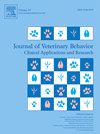使用多模式治疗减少混合品种犬重复追尾
IF 1.3
3区 农林科学
Q4 BEHAVIORAL SCIENCES
Journal of Veterinary Behavior-clinical Applications and Research
Pub Date : 2025-03-01
DOI:10.1016/j.jveb.2025.03.001
引用次数: 0
摘要
29.5 公斤,2.25岁,雄性,罗得西亚脊背杂交犬,因过度旋转和追逐尾巴而出现。这些行为只发生在室内,只有当有人在场的时候,有4个不同的收养人,至少有6种不同的住房情况。重复行为的范围从不变的无明显功能的旋转到更多的目标导向的尾巴追逐,后者是主导行为。大约50%的时候,有一个明显的触发因素,但另外50%的时候,行为似乎是自发的,没有明显的触发因素。身体和神经检查无明显异常。最小的诊断数据库,包括全血细胞计数、化学特征、甲状腺素水平和常见蜱传疾病血清学,没有发现任何异常。进一步的诊断测试建议排除潜在的医学原因或异常重复行为(ARB)的贡献者。其他测试建议包括脊柱和尾部x光片,止痛药试验,以及转介给兽医神经科医生进行高级诊断,包括磁共振成像(MRI)和脑脊液(CSF)分析。由于资金紧张,客户拒绝了进一步的测试。患者被诊断为强迫症(OCD/CD)。药物选择包括疼痛和抗焦虑药物试验。客户选择最初用抗焦虑药物治疗OCD/CD,如果反应最小,计划增加止痛药试验。选择曲唑酮是因为它具有快速镇静和/或轻度镇静作用。迅速减少这种行为的持续时间和频率是很重要的,因为客户表示,如果不能及时证明改善,他们正在考虑重新安置病人或对病人实施安乐死。曲唑酮是血清素拮抗剂和再摄取抑制剂(SARI)。它经常被用作催眠和非典型抗焦虑药物。在曲唑酮开始治疗两周后,患者报告ARB频率和强度降低了25%,几乎没有镇静。选择性血清素再摄取抑制剂(SSRI)氟西汀因其抗焦虑和抗强迫/强迫/焦虑作用而加入。此外,还实施了行为管理策略,包括避免厌恶的互动,尽量减少已识别的行为触发因素,以及增强环境丰富性以提高整体福利。研究人员使用食物和食物玩具来改变狗的行为,以对抗噪音或压力等触发因素。客户被建议通过重新引导狗进行替代的、不相容的活动来预防这种行为,因为它得到了奖励。如果这种行为已经开始,客户被指示忽略这种行为并平静地离开房间。如果狗狗停止旋转或跟随客户,他们可以要求狗狗做出其他行为,并加强这种行为。在三个月的随访咨询中,客户报告了显著的改善,行为频率、持续时间和强度减少了80%。在三个月后的电子邮件随访中,客户报告了持续的改善。这种行为现在不常见了,每周只发生两到四次。该患者的早期病史、正常的实验室检查结果、正常的身体和神经检查以及观察到的重复行为支持强迫症/CD的诊断,表现为旋转和追尾,并伴有焦虑。本文章由计算机程序翻译,如有差异,请以英文原文为准。
Reduction of repetitive tail chasing in a mixed breed dog using multimodal therapy
A 29.5 kg, 2.25 year old, neutered, male, Rhodesian Ridgeback crossbreed dog presented for excessive spinning and tail chasing. These behaviors occurred exclusively indoors, only when people were present, with 4 different adopters, and in at least 6 different housing situations. The repetitive behaviors ranged from invariant spinning with no apparent function to more goal-directed tail chasing, the latter being the predominant behavior. Approximately 50% of the time, there was a notable trigger, but the other 50% of the time, the behavior appeared to start spontaneously without a discernable trigger.
Physical and neurological examinations were unremarkable. A minimum diagnostic database, including a complete blood count, chemistry profile, total thyroxine level, and common tick-borne disease serology, did not reveal any abnormalities. Further diagnostic testing was recommended to rule out potential medical causes or contributors to the abnormal repetitive behavior (ARB). Additional testing recommendations included spinal and tail radiographs, a pain medication trial, and referral to a veterinary neurologist for advanced diagnostics, including magnetic resonance imaging (MRI) and cerebrospinal fluid (CSF) analysis. The clients declined further testing due to financial constraints.
The patient was diagnosed with obsessive-compulsive/compulsive disorder (OCD/CD). Pharmaceutical options included pain and anxiolytic medication trials. The clients elected to initially treat the OCD/CD with anxiolytic medication, with a plan to add a pain medication trial if the response was minimal. Trazodone was chosen for its profile of fast calming and/or mildly sedative effects. Reducing the duration and frequency of the behavior quickly was important as the clients indicated they were contemplating rehoming or euthanizing the patient if improvement could not be promptly demonstrated. Trazodone is a serotonin antagonist and reuptake inhibitor (SARI). It is often used as a hypnotic and atypical anxiolytic medication. Two weeks after initiating trazodone, the clients reported a 25% reduction in the ARB frequency and intensity, with minimal to no sedation. The selective serotonin Reuptake Inhibitor (SSRI), fluoxetine, was added because of its anti-anxiety and anti-obsessional/compulsive/anxiety effects.
Behavioral management strategies were also implemented, including avoiding aversive interactions, minimizing identified triggers of the behavior, and enhancing environmental enrichment to improve overall welfare. Behavior modification using treats and food toys was used to counter-condition the dog to triggers such as noises or stressful situations. The clients were advised to preempt the behavior by redirecting the dog to alternate, incompatible activities for which he was rewarded. If the behavior had already begun, the clients were instructed to ignore the behavior and calmly leave the room. If the dog stopped spinning or followed the clients, they could ask the dog for alternate behavior and reinforce that behavior.
At a three-month follow-up consultation, the clients reported significant improvement, with an 80% reduction in behavior frequency, duration, and intensity. In an email follow-up three months later, the clients reported continued improvement. The behaviors were now infrequent, occurring only two to four times per week.
This patient’s early history, normal laboratory results, unremarkable physical and neurological examinations, and observed repetitive behavior support a diagnosis of OCD/CD manifested as spinning and tail-chasing associated with anxiety owing to early experiences and management.
求助全文
通过发布文献求助,成功后即可免费获取论文全文。
去求助
来源期刊
CiteScore
3.50
自引率
16.70%
发文量
107
审稿时长
325 days
期刊介绍:
Journal of Veterinary Behavior: Clinical Applications and Research is an international journal that focuses on all aspects of veterinary behavioral medicine, with a particular emphasis on clinical applications and research. Articles cover such topics as basic research involving normal signaling or social behaviors, welfare and/or housing issues, molecular or quantitative genetics, and applied behavioral issues (eg, working dogs) that may have implications for clinical interest or assessment.
JVEB is the official journal of the Australian Veterinary Behaviour Interest Group, the British Veterinary Behaviour Association, Gesellschaft fr Tierverhaltensmedizin und Therapie, the International Working Dog Breeding Association, the Pet Professional Guild, the Association Veterinaire Suisse pour la Medecine Comportementale, and The American Veterinary Society of Animal Behavior.

 求助内容:
求助内容: 应助结果提醒方式:
应助结果提醒方式:


